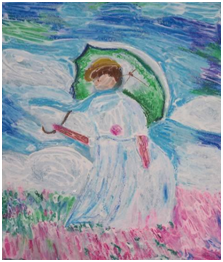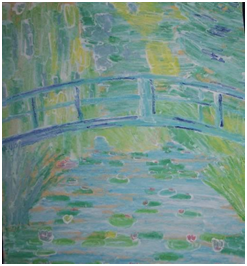Impressionism is a style of art loved by many but often difficult for young artists to recreate. By using a couple of simple Sargent Art products, students will amaze themselves.
Goal (Terminal Objective):
Students will learn about impressionism and Claude Monet.
Objective:
The students will create a composition inspired by Monet using the style of impressionism.
National Standards:
Visual Arts Grades 58 Content Standard 1: Understanding and applying media, techniques, and processes
Visual Arts Grades 58 Content Standard 2: Using knowledge of structures and functions
Visual Arts Grades 58 Content Standard 3: Choosing and evaluating a range of subject matter, symbols, and ideas
Visual Arts Grades 58 Content Standard 4: Understanding the visual arts in relation to history and cultures
Visual Arts Grades 58 Content Standard 5: Reflecting upon and assessing the characteristics and merits of their work and the work of others
Visual Arts Grades 58 Content Standard 6: Making connections between visual arts and other disciplines (Social Studies, World History, and English Cross Curriculum Connection)
Purpose:
The students will create a composition based on Monet and his style of impressionism.
Students will create a functional gift wrap design and product.
New Vocabulary:
Claude Monet, impressionism, plein air
Materials:
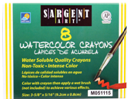
#22-1108 8 ct. Watercolor Crayons

#17-3696 128 oz Gallon white Washable Art-Time Tempera paint

#23-4001 50 ct. Construction Paper Pack

#22-7244 144 ct. Graphite Pencils (Optional
damp paper towels, small pictures of Monet’s paintings (old calendars and a Google Image search work very well)
Time:
2 or more art periods depending on size of paper and degree of complexity desired.
Introduction and Motivation (Set):
Ask the students if they have ever drawn or painted while outdoors. Explain that this is called plein air drawing or painting. Show pictures of Claude Monet’s work and give a brief biography (1840 1926, France, impressionism). Impressionism was just that, a fleeting impression of the subject captured in time. Light and color were very important to the impressionists. Monet often painted the same subject numerous times at various times of the day or seasons of the year trying to capture the way the light made the colors change. Work was done very quickly. Up very close impressionist paintings often look blurry or like just a bunch of colorful brush strokes. But when you step back a little it all starts to make sense. When Monet was older he settled down in the French town of Giverny. There he purchased a large house and had wonderful gardens with a pond built. Some of his most famous paintings were of his water lilies that were growing in the pond. Some of these paintings are over 40 feet wide!
Instruction:
Have students look at the pictures you have provided and select one for study. If the picture has mostly blues or greens, select the appropriate color of paper. Using the Sargent Art watercolor crayons, dip the end of the crayon into Sargent Art white tempera paint. Begin to draw with that and the watercolor crayon will mix with the paint providing a very painterly look.
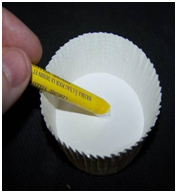
Dip only the tip intothepaint
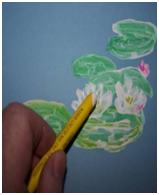
Draw with thepaintedtip
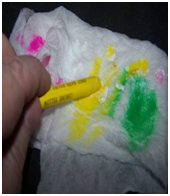
Clean off excess paint ona damp paper towel
Look for the direction that the plants or objects go and try to capture that in the composition. Do not use black as the impressionists never used that color. Clean off the tip of the watercolor crayon with a damp paper towel so that the white tempera paint will not dry on it. With young students be prepared for them to start over and over since they are used to striving for realism. Use of pencils should be discouraged since they will spend lots of time trying to draw in every little detail.
Activities:
(1) Guided Practice:
- Select a picture to use as guide.
- Select appropriate color of paper.
- Dip the tip of the Sargent Art watercolor crayon into the Sargent Art white tempera paint and begin to draw with it capturing the movement of the subject.
- DO NOT USE BLACK!
- Clean the white paint off the tip of the crayon using a paper towel.
(2) Independent Practice and Check for Understanding: The teacher will circulate among the students as they work to make sure that they are staying with the objectives of this composition. Ask direct questions when understanding is not being observed. The teacher will help when necessary and add positive reinforcement as the students work.
(3) Closure: Students display their work. The teacher will guide a critique to help younger students to learn the process. Point out the strong qualities of successful compositions.
Evaluation:
Teacher will evaluate the works individually based on the following criteria
Level One — Completed project captures the movement of the subject matter represented by brush strokes in the original painting. The completed composition does not have lots of details. Colors have been blended into the white tempera paint. The selection of colors does not include black. The style of impressionism has been used. Craftsmanship is excellent.
Level Two — Completed project captures most of the movement of the subject matter represented by brush strokes in the original painting. The completed composition has a few details. Colors have been blended into the white tempera paint. The selection of colors does not include black. The style of impressionism has been attempted. Craftsmanship is good.
Level Three — Completed project captures some of the movement of the subject matter represented by brush strokes in the original painting. The completed composition has some details. Colors have mostly been blended into the white tempera paint. The selection of colors does not include black.The style of impressionism is somewhat attempted. Craftsmanship is variable.
Level Four — Completed project captures a little of the movement of the subject matter represented by brush strokes in the original painting but appears scribbled. The completed composition has some details. Colors have not been completely blended into the white tempera paint. The selection of colors includes black. The style of impressionism is not evident. Craftsmanship is poor.
Extension:
Students could write a report about Monet or other impressionist painters of Monet’s time. Use the Internet to look on a map to find Giverny.
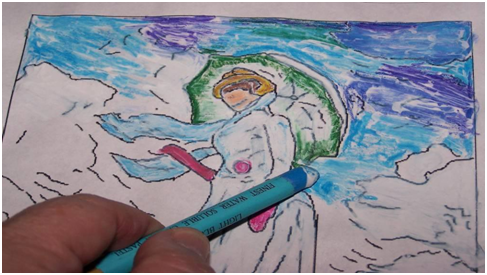
http://www.schoolplaten.com/nlkleurplaatkleurplatenfotomoneti3120.html
Resources:
http://en.wikipedia.org/wiki/Tie-dye
Art Consultant



